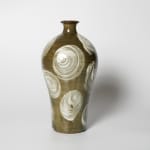Matsuzaki Ken 松崎 健
H26.4 x Dia 12.7 cm
Further images
Matsuzaki Ken (b. 1950, Tokyo)’s painted surfaces are full of energy. His iron, white clay slip, and other glaze types showcase the potter’s mastery over brushwork over his Mashiko clay surfaces. He began studying ceramics at age 16, and after graduating Tamagawa University’s College of Arts, he moved to Mashiko in pursuit of his ceramic career. He was a student of Shimaoka Tatsuzo, who shared a similar background to Matsuzaki. Both were born in Tokyo and grew a strong passion for Mingei and Mashiko yaki from a young age. He studied under Shimaoka for about five years, between 1972 to 1977. Towards the end of his apprenticeship, he had begun developing his own style. In particular, he developed his own pictorial and calligraphic motifs on his ceramic functional Mingei vessels. In the spirit of studio pottery, he mainly uses wood firing for his kilns.
This jar form echoes the form of the Chinese Meiping, with a thin bottle neck and rounded shoulders. The curved silhouette is decorated with hand painted white slip.
His works are collected internationally and appreciated by Mingei collectors around the globe. Having been featured into the permanent collection of multiple museums, such as the British Museum, Metropolitan Museum of Art, Victoria and Albert Museum, Museum of Fine Arts, Boston, Asian Art Museum, San Francisco, the Cleveland Museum of Art, Museum of the City of Landoshut, Germany, and many more.
Matsuzaki Ken (b. 1950, Tokyo)’s painted surfaces are full of energy. His iron, white clay slip, and other glaze types showcase the potter’s mastery over brushwork over his Mashiko clay surfaces. He began studying ceramics at age 16, and after graduating Tamagawa University’s College of Arts, he moved to Mashiko in pursuit of his ceramic career. He was a student of Shimaoka Tatsuzo, who shared a similar background to Matsuzaki. Both were born in Tokyo and grew a strong passion for Mingei and Mashikoyaki from a young age. He studied under Shimaoka for about five years, between 1972 to 1977. Towards the end of his apprenticeship, he had begun developing his own style. In particular, he developed his own pictorial and calligraphic motifs on his ceramic functional Mingei vessels. In the spirit of studio pottery, he mainly uses wood firing for his kilns.
This jar form echoes the form of the Chinese Mei ping, with a thin bottle neck and rounded shoulders. The curved silhouette is decorated with hand painted white slip.
His works are collected internationally and appreciated by Mingei collectors around the globe. Having been featured into the permanent collection of multiple museums, such as the British Museum, Metropolitan Museum of Art, Victoria and Albert Museum, Museum of Fine Arts, Boston, Asian Art Museum, San Francisco, the Cleveland Museum of Art, Museum of the City of Landoshut, Germany, and many more.













